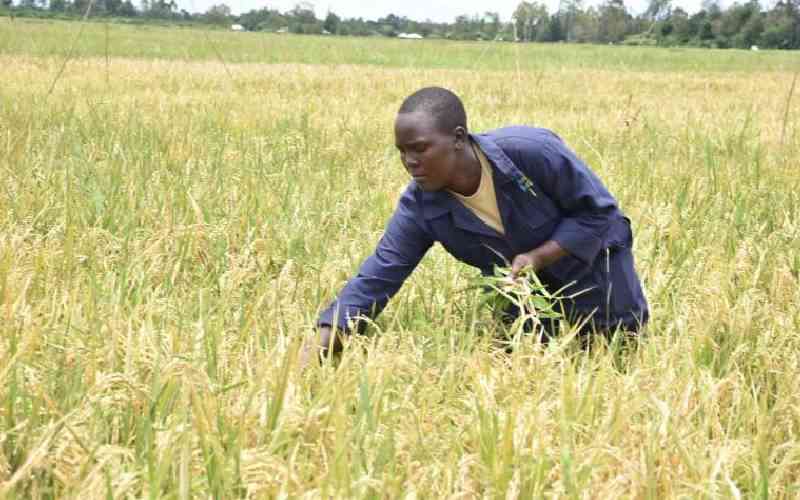Unhealthy soil can significantly reduce yields. It is therefore imperative that farmers develop farming practices that would improve soil health instead of reacting after the symptoms manifest.
First, practice minimum tillage. Minimal tillage maintains natural aggregates, one of the key components of soil health, and helps prevent loose soil particles from washing or blowing away easily. Residue decomposes more slowly under a reduced tillage system. The decreased soil disturbance keeps biological activity and organic matter decomposition near the surface and helps maintain a soil structure that allows rainfall to infiltrate rapidly.
Leaving residue on the surface, or applying mulches, has a dramatic impact on soil biological activity. It encourages the development of earthworm populations, maintains soil moisture and moderates temperature extremes.
Compared with conventional tillage, soil erosion (water, wind or tillage) is greatly reduced under minimum-tillage systems, which help keep organic matter and rich topsoil in place. Any other practices that reduce soil erosion, such as contour tillage, strip cropping along the contours and terracing, also help maintain soil organic matter.
Second, practice crop rotation. Crop rotation is a practice of growing different crops on the same land in a regular recurring sequence. It means the planned order of specific crops planted on the same field. It also means that the succeeding crop belongs to a different family than the previous one. The planned rotation may vary from 2 or 3 years to longer period. Rotation of crops is not only necessary to offer a diverse “diet” to the soil microorganisms, but as they are rooting at different soil depths hence are capable to explore the different soil layers for nutrients.
Third, include cover crops. Cover crop roots improve soil aggregation and reduce erosion. Cover crop residue also reduces the impact of raindrops on the soil surface and serves as a habitat and food source for soil microbes. As organisms decompose the residue, nutrients are released back into the soil. Organic matter, a key soil health component, can increase over a longer period as residue is added back into the system. There are two ways to use cover crops. One way is to simply plant the cover crop once you’ve grown and harvested your regular crop. This way the soil is not left bare, and the cover crop basically becomes mulch for the next growing season.
The second way is to mix the cover crop in with the regular crops during the growing season. Here, you have to make sure the crops go well together. Some farmers will grow cowpeas or soybeans next to their corn. The legume will build underground network, and they feed each other, share resources: nutrients, phosphorus, and water. It’s just beautiful.
Fourth, Nutrients management which goes hand-in-hand with the first three strategies I have discussed. You may need to adjust your fertiliser applications after switching to a reduced tillage system, adding a cash crop, or implementing cover crops in your rotation. As organic matter increases, you may see an increase in your soil’s ability to hold nutrients longer.
Keep your local extension officer in the loop as you make changes to your system, so he can give you recommendations to fit your specific needs. Over-applying fertilisers can reduce mycorrhizal fungi’s natural ability to scavenge nutrients for plants and can harm some species’ abilities to colonise in the future. Make it a routine practice to test your soil once every two years. A good analogy is to think of your soil as a bank account with credits and debits. The credits are management practices that improve soil health, like manure additions, reduced tillage and cover crops. The debits are the ones that degrade the soil, like compaction from field traffic and intensive tillage.
 The Standard Group Plc is a
multi-media organization with investments in media platforms spanning newspaper
print operations, television, radio broadcasting, digital and online services. The
Standard Group is recognized as a leading multi-media house in Kenya with a key
influence in matters of national and international interest.
The Standard Group Plc is a
multi-media organization with investments in media platforms spanning newspaper
print operations, television, radio broadcasting, digital and online services. The
Standard Group is recognized as a leading multi-media house in Kenya with a key
influence in matters of national and international interest.
 The Standard Group Plc is a
multi-media organization with investments in media platforms spanning newspaper
print operations, television, radio broadcasting, digital and online services. The
Standard Group is recognized as a leading multi-media house in Kenya with a key
influence in matters of national and international interest.
The Standard Group Plc is a
multi-media organization with investments in media platforms spanning newspaper
print operations, television, radio broadcasting, digital and online services. The
Standard Group is recognized as a leading multi-media house in Kenya with a key
influence in matters of national and international interest.









